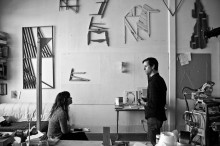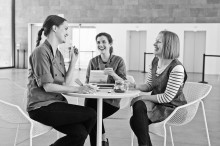THE POSSIBLE
From the start it was something that took its time to unfold. Our first meeting about “The Possible” was over coffee with Larry Rinder, David Wilson, and Aimee Chang at the café tucked in the courtyard of Berkeley Art Museum. That was over a year ago— and now I can’t really remember how it came to be that we had been invited to sit and talk with them, I just remember that there we were, discussing the possibility of somehow being involved in a big, epic-sounding exhibition at BAM/PFA called “The Possible”. At that point the details concerning the exhibition were loose, undetermined, and somewhat speculative; there was obvious uncertainty about what it would be, but within that uncertainty there was remarkable curiosity and enthusiasm. I suppose that’s why we knew we had to say yes, though we had no idea what we were getting ourselves into.
Curated by David Wilson, “The Possible” is something of an experiment, operating on a grand yet informal scale it purposefully is unconcerned with showcasing finished objects, and instead offers a series of interdisciplinary encounters for visiting artists and museumgoers alike. The gallery spaces have been reconfigured into a series of work areas— there is a ceramics studio, a dye lab, print shop, and recording studio, and in this public forum, guest artists are invited to collaborate with one another, to explore new practices and processes, and to create work. The studios also function somewhat as classrooms during the series of Sunday Workshops, when audiences are invited to participate in discussions, performances, and field trips over the course of the exhibition, which runs until May 25th.
For a long while after our initial meeting with Larry, David, and Aimee we still didn’t know much about what “The Possible” would actually become and therefore we were unsure about how to approach our role in documenting the initial period of the exhibition. Even when we met with David right before “The Possible” opened in late January, when so many details had been nailed down and were now real enough to be put on a calendar… even by then, I don’t think we had a handle on what this exhibit was all about. I think David’s advice to us was something like, “ Don’t overthink it, just go with it.” And so we did— For the month of February Klea and I came to the museum on a regular basis to observe and document the early stages of the exhibition’s activity. The very first day we came, we didn’t do anything other than wander around and watch. I had come with my recorder and Klea with her camera, ready to interview and film… but immediately we knew we couldn’t just jump in like that, we had to let things sink in, we had to ease into the space and everything that was happening in it. Walking into “The Possible” is a bewildering experience— the various work spaces just exist, they aren’t really noticeably designated, and artists are working, with their heads down and their hands busy, and the building echoes with voices and sometimes music, and it’s easy to feel intimidated and uncertain. But then you realize you just have to kind of give yourself over to the experience and let yourself wander and naturally you begin to gravitate towards certain activities and the people involved.
Everyone we met, both artists and visitors, were eager to talk about their experiences with “The Possible”— I think for many people the exhibit has felt special in it’s aberration from the norm and therefore has made a lasting impression. I think a lot of people are overwhelmed and confused by it, or at least initially, and many are also immediately thrilled and inspired. I think it’s interesting how an exhibit like “The Possible” which has so purposefully been laid bare and has done away with the typical luster of a museum show, can still feel inaccessible or intimidating. Certainly, I often felt overwhelmed by “The Possible”… mostly because it was never the same, each time I left it, I felt like I had to get to know it all over again when I came back, even if it was just the very next day. It’s the most unpredictable exhibit I have ever been to, perhaps in moments that makes it messy and difficult and hard to follow, but it also makes it truly alive, unfolding, knocking against what is and isn’t possible.
THE POSSIBLE RUNS UNTIL MAY 25th, 2014. LEARN MORE HERE AND HERE.




